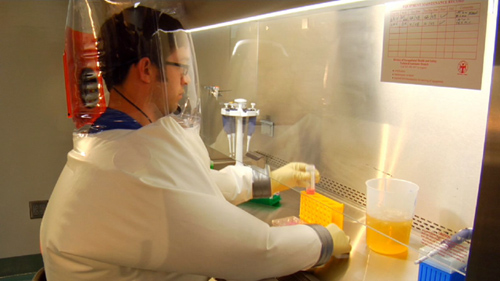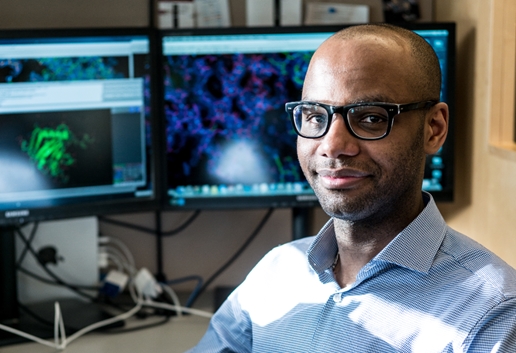Ebola
Shining Light on Ebola Virus for Faster Diagnosis
Posted on by Dr. Francis Collins

Caption: A rapid Ebola detection system consisting of a microfluidic chip (left) and an optofluidic chip (right), connected by a curved tube (center).
Credit: Joshua Parks, University of California, Santa Cruz
Many lessons were learned during last year’s devastating outbreak of Ebola virus disease in West Africa. A big one is that field clinics operating in remote settings desperately need a simple, rapid, and accurate test that can tell doctors on the spot—with just a drop of blood—whether or not a person has an active Ebola infection.
A number of point-of-care tests are under development, and it’s exciting to see them moving in the right direction to fill this critical need [1]. As a recent example, a paper published in Nature Scientific Reports by a team of NIH-supported researchers and colleagues shows early success in rapid Ebola detection with an automated lab on a chip [2]. The hybrid system, which combines microfluidics for sample preparation with optofluidics for viral detection, identifies Ebola at concentrations that are typically seen in the bloodstream of an infected person. It also distinguishes between Ebola and the related Marburg and Sudan viruses, suggesting it could be used to detect other infectious diseases.
From Ebola Researchers, An Anthem of Hope
Posted on by Dr. Francis Collins
After watching this music video, you might wonder what on earth it has to do with biomedical science, let alone Ebola research. The answer is everything.
This powerful song, entitled “One Truth,” is dedicated to all of the brave researchers, healthcare workers, and others who have put their lives on the line to save people during the recent outbreak of Ebola virus disease. What’s more, it was written and performed by seven amazing scientists—one from the United States and six from West Africa.
Snapshots of Life: Visualizing Blood Vessels
Posted on by Dr. Francis Collins
This might look a bit like a fish net, but what’s actually caught in this image is the structure of the endothelium—the thin layer of cells lining your blood vessels that controls the flow of molecules in and out of the bloodstream. The red lines are the actin filaments that give each endothelial cell its shape, while the purple are proteins called cadherins.
Most of the time, the actin “ropes” and cadherin “glue” act together to form a tight seal between endothelial cells, ensuring that nothing leaks out of blood vessels into surrounding tissue. However, when endothelial cells sense an infection or an injury, the cadherins open gaps that allow various disease-fighting or healing factors or cells present in the blood to breach the barrier and enter infected or injured tissue. After the infection subsides or wound heals, the gaps close and the blood vessel is once again impenetrable.
NIH Ebola Update: Working Toward Treatments and Vaccines
Posted on by Drs. Anthony S. Fauci and Francis S. Collins
Updated Oct. 22, 2014: The National Institutes of Health (NIH) today announced the start of human clinical trials of a second Ebola vaccine candidate at the NIH Clinical Center in Bethesda, MD. In this early phase trial, researchers from NIH’s National Institute of Allergy and Infectious Diseases (NIAID) are evaluating the vaccine, called VSV-ZEBOV, for its safety and ability to generate an immune response in healthy adults who receive two intramuscular doses, called a prime-boost strategy.
The Walter Reed Army Institute of Research is simultaneously testing the vaccine candidate as a single dose at its Clinical Trials Center in Silver Spring, MD. VSV-ZEBOV, which was developed by researchers at the Public Health Agency of Canada’s National Microbiology Laboratory, has been licensed to NewLink Genetics Corp. through its wholly owned subsidiary BioProtection Systems, both based in Ames, Iowa.
Early human testing of another Ebola vaccine candidate, co-developed by NIAID and GlaxoSmithKline, began in early September at the NIH Clinical Center. Initial data on that vaccine’s safety and ability to generate an immune response are expected by the end of 2014.
We are all alarmed by the scope and scale of the human tragedy occurring in West African nations affected by the Ebola virus disease epidemic. While the cornerstones of the Ebola response remain prompt diagnosis and isolation of patients, tracing of contacts, and proper protective equipment for healthcare workers, the National Institutes of Health (NIH), led by its National Institute of Allergy and Infectious Diseases (NIAID), is spearheading efforts to develop treatments and a vaccine for Ebola as quickly as possible.
For example, NIAID has supported and collaborated with Mapp Biopharmaceutical, Inc., San Diego, in its development of the product known as ZMapp, which has been administered experimentally to several Ebola-infected patients. While it is not possible at this time to determine whether ZMapp benefited these patients, NIAID is supporting a broader effort to advance development and clinical testing of ZMapp to determine if it is safe and effective. In addition, the U.S. Biodefense Advanced Research and Development Agency (BARDA) has announced plans to optimize and accelerate the manufacturing of ZMapp, which is in limited supply, to enable clinical safety testing to proceed as soon as possible.
Using Genomics to Follow the Path of Ebola
Posted on by Dr. Francis Collins

Caption: Colorized scanning electron micrograph of filamentous Ebola virus particles (blue) budding from a chronically infected VERO E6 cell (yellow-green).
Credit: National Institute of Allergy and Infectious Diseases, NIH
Long before the current outbreak of Ebola Virus Disease (EVD) began in West Africa, NIH-funded scientists had begun collaborating with labs in Sierra Leone and Nigeria to analyze the genomes and develop diagnostic tests for the virus that caused Lassa fever, a deadly hemorrhagic disease related to EVD. But when the outbreak struck in February 2014, an international team led by NIH Director’s New Innovator Awardee Pardis Sabeti quickly switched gears to focus on Ebola.
In a study just out in the journal Science [1], this fast-acting team reported that it has sequenced the complete genetic blueprints, or genomes, of 99 Ebola virus samples obtained from 78 patients in Sierra Leone. This new genomic data has revealed clues about the origin and evolution of the Ebola virus, as well as provided insights that may aid in the development of better diagnostics and inform efforts to devise effective therapies and vaccines.
Eradicating Ebola: In U.S. Biomedical Research, We Trust
Posted on by Dr. Francis Collins

Caption: Researcher inside a biosafety level 4 laboratory, which provides the necessary precautions for working with the Ebola virus.
Credit: National Institute of Allergy and Infectious Diseases, NIH
Updated August 28, 2014: Today, the National Institutes of Health (NIH) announced plans to begin initial human testing of an investigational vaccine to prevent Ebola virus disease. Testing of the vaccine, co-developed by NIH’s National Institute of Allergy and Infectious Diseases (NIAID) and GlaxoSmithKline, will begin next week at the NIH Clinical Center in Bethesda, MD.
As the outbreak of Ebola Virus Disease continues to spread in West Africa, now affecting four countries in the region, I am reminded how fragile life is—and how important NIH’s role is in protecting it.
NIH research has helped us understand how Ebola initially infects people and how it spreads from person to person. Preventing this spread is currently our greatest defense in fighting it. Through research, we know that the Ebola virus is transmitted through direct contact with bodily fluids and is not transmitted through the air like the flu. We also know the symptoms of Ebola and the period during which they can appear. This knowledge has informed how we manage the disease. We know that the virus can be contained and eradicated with early identification, isolation, strict infection control, and meticulous medical care.
Tracking a Deadly Virus
Posted on by Dr. Francis Collins
If you think that studying the deadly Ebola virus is all about donning a biohazard suit in a high-tech lab, think again. Check out these scientists from the National Institute of Allergy and Infectious Diseases and their collaborators as they travel to a remote village in the Republic of the Congo to search for Ebola and other emerging viruses. Watch them set up camp in the jungle and take blood samples from animals that may harbor these viruses.
Previous Page





